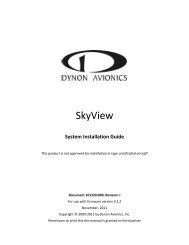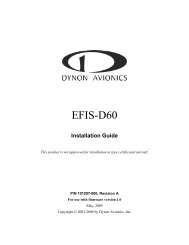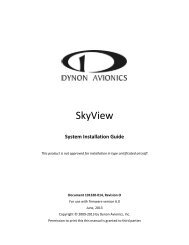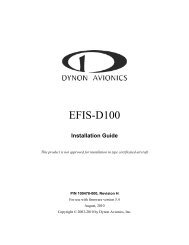1. Autopilot In-Flight Tuning Procedures Flight Test ... - Dynon Avionics
1. Autopilot In-Flight Tuning Procedures Flight Test ... - Dynon Avionics
1. Autopilot In-Flight Tuning Procedures Flight Test ... - Dynon Avionics
You also want an ePaper? Increase the reach of your titles
YUMPU automatically turns print PDFs into web optimized ePapers that Google loves.
<strong>1.</strong> <strong>Autopilot</strong> <strong>In</strong>‐<strong>Flight</strong> <strong>Tuning</strong> <strong>Procedures</strong><strong>Flight</strong> <strong>Test</strong> PreparationThe flight test should be conducted on a clear, VFR day. It is recommended thatclearing turns be performed before executing each procedure.At many points, the pilot’s attention will be divided between documentation,configuring SkyView, and maintaining situational awareness. Before commencingthe flight test, ensure that you have adequate altitude, clear weather, no traffic, noobstructions in the flight path, great visibility, no airspace conflicts, etc. If possible,bring someone along on the first autopilot test flight.If autopilot behavior, performance, or interference with the controls is cause for concern whileflying, remember that the autopilot can be disconnected in any of the following ways:• Press the Disconnect/CWS button• If using the SIMPLIFIED controls:o Enter the AP Menu (MAIN MENU > AP MENU) and press the TRK+ALT button• indicates the autopilot is engaged• indicates the autopilot is not engaged• If using the EXPERT controls:o Enter the AP Menu (MAIN MENU > AP MENU) and press the AP button• indicates the autopilot is engaged• indicates the autopilot is not engaged• Turn off the autopilot circuit breaker/switch or remove the fuseSkyView <strong>Autopilot</strong> <strong>In</strong>‐<strong>Flight</strong> <strong>Tuning</strong> Guide ‐ Revision A 1‐1
<strong>Autopilot</strong> <strong>In</strong>‐<strong>Flight</strong> <strong>Tuning</strong> <strong>Procedures</strong>Roll Axis <strong>In</strong>‐<strong>Flight</strong> <strong>Tuning</strong> ProcedureThis procedure tunes the roll autopilot servo and thus, the flight characteristics of the aircraft inheading holds and turns. This procedure should be performed with the autopilot roll axis intrack (TRK+ALT) mode, where the purpose of the autopilot is to keep the aircraft’s GPS groundtrack aligned with the track bug (as well as hold altitude). Before executing this procedure:<strong>1.</strong> The autopilot controls should be changed to SIMPLE mode (SETUP MENU > AUTOPILOTSETUP > AUTOPILOT CONTROLS)<strong>In</strong>‐<strong>Flight</strong> ProcedureThe following list is an overview of the procedure. Each step is described in more detail afterthe list, in flow‐chart and textual formats.<strong>1.</strong> Establish trimmed level flight on a fixed heading2. Engage <strong>Autopilot</strong> (AP) in TRK+ALT mode3. Allow a few minutes of stable flight under AP control4. Change the TRK target 90 degrees from the current target5. Check for ROLL SLIP indicationsa. If observed, disconnect AP, increase ROLL TORQUE by 10% and start overb. If ROLL TORQUE is already set to 100%, contact <strong>Dynon</strong>6. Check if aircraft is slow to responda. If observed, disconnect AP, increase ROLL SENSITIVITY by 2 and start overb. If ROLL SENSITIVITY is already maxed out, contact <strong>Dynon</strong>7. Check if aircraft is “twitchy” in ROLL axisa. If observed, decrease ROLL SENSITIVITY by 1b. Change the TRK target 90 degrees from the current targetc. Check if aircraft overshoots TRK targeti. If observed, disconnect AP, increase ROLL GAIN by 0.2 and start over8. Check if aircraft overshoots TRK targeta. If observed and you have been changing ROLL GAIN, disconnect AP, increaseROLL GAIN by 0.2 and start overb. If observed and you have not been changing ROLL GAINi. If ROLL SENSITIVITY is maxed out, disconnect AP, increase ROLL GAIN by0.2 and start overii. Otherwise, disconnect AP, increase ROLL SENSITIVITY by 2 and start over9. Verify acceptable AP Roll performancea. If unacceptable, refer to Roll Troubleshooting Sectionb. If acceptable, procedure is complete1‐2 SkyView <strong>Autopilot</strong> <strong>In</strong>‐<strong>Flight</strong> <strong>Tuning</strong> Guide ‐ Revision A
<strong>Autopilot</strong> <strong>In</strong>‐<strong>Flight</strong> <strong>Tuning</strong> <strong>Procedures</strong>Detailed FlowchartFigure 1 – Roll Axis – <strong>Flight</strong> <strong>Test</strong> ProcedureSkyView <strong>Autopilot</strong> <strong>In</strong>‐<strong>Flight</strong> <strong>Tuning</strong> Guide ‐ Revision A 1‐3
<strong>Autopilot</strong> <strong>In</strong>‐<strong>Flight</strong> <strong>Tuning</strong> <strong>Procedures</strong>Detailed Explanation<strong>1.</strong> Establish trimmed level flight on a fixed headingYou should start the procedure by placing the aircraft in level flight, in neutral trim, on a fixedheading. Try to maintain a constant altitude during the procedure.2. Engage the <strong>Autopilot</strong> (AP) in TRK+ALT modTo engage the autopilot in TRK+ALT mode:<strong>1.</strong> Enter the AP Menu (MAIN MENU > AP)2. Press button 3, TRK+ALT3. It should be highlighted and look likeNote that the heading (HDG) bug under the DG changes to the track (TRK) bug in track mode.3. Allow a few minutes of stable flight under AP controlEnsure that you are not affecting the autopilot’s control of the roll axis, so you can determinethe autopilot’s track hold and turn performance.4. Change the TRK target 90 degrees from the current targetChange the heading bug to 90 degrees to the left or right of current heading.<strong>1.</strong> Configure a joystick to control the heading bug. The label above the joystick should read(TRK)2. Turn the joystick either way until the track bug reads 90 degrees to the left or right ofcurrent TRK target3. The aircraft should immediately begin turning toward the new TRK target5. Check for ROLL SLIP indicationsObserve the autopilot status indicator on the Top Bar while the autopilot flies. If thebanner is shown frequently, it is an indication that the roll servo is slipping andthe servo torque needs to be increased. Occasional slips due to turbulence are acceptable.If frequent ROLL SLIPS are observed, disconnect the autopilot and increase ROLL TORQUE by10% (SETUP MENU > AUTOPILOT SETUP > ROLL AXIS > TORQUE).If you have adjusted the roll servo torque to 100% and are still seeing frequentslips, you may need to try a higher strength servo (e.g., if you have an SV32installed, try swapping for an SV42). Contact <strong>Dynon</strong> for assistance.6. Check if aircraft is slow to respondObserve the speed at which the autopilot responds to changes in TRK setting.If the autopilot seems too slow to respond or “sluggish”, disconnect the autopilot and increaseROLL SENSITIVITY by 2 (SETUP MENU > AUTOPILOT SETUP > ROLL AXIS > SENSITIVITY).1‐4 SkyView <strong>Autopilot</strong> <strong>In</strong>‐<strong>Flight</strong> <strong>Tuning</strong> Guide ‐ Revision A
<strong>Autopilot</strong> <strong>In</strong>‐<strong>Flight</strong> <strong>Tuning</strong> <strong>Procedures</strong>If you have adjusted the roll servo sensitivity to its maximum setting and are stillobserving unacceptably slow behavior, contact <strong>Dynon</strong> for assistance.7. Check if aircraft is “twitchy” in ROLL axisObserve if the flight controls twitch excessively or seem overly aggressive.If it does, this is an indication that the ROLL SENSITIVITY needs to be decreased. Decrease ROLLSENSITIVITY by 1 (SETUP MENU > AUTOPILOT SETUP > ROLL AXIS > SENSITIVITY). There is noneed to disconnect the autopilot before making this change.After making this adjustment, change the TRK target 90 degrees from the current target, andcheck if the autopilot overshoots the new TRK target. If TRK target overshoot is observed,disconnect the autopilot, increase ROLL GAIN by 0.2 (SETUP MENU > AUTOPILOT SETUP > ROLLAXIS > GAIN) and start over. Otherwise, proceed to the next step.8. Check if aircraft overshoots TRK targetObserve if the autopilot is overshooting or wandering around the track target. The autopilotshould keep the open triangle of the track bug closely aligned with the small, magenta groundtrack triangle.If an overshoot is observed and you made a recent ROLL GAIN adjustment, disconnect theautopilot, increase ROLL GAIN by 0.2 (SETUP MENU > AUTOPILOT SETUP > ROLL AXIS > GAIN)and start overOtherwise, if you have not made a recent ROLL GAIN adjustment:<strong>1.</strong> If ROLL SENSITIVITY is maxed out, disconnect the autopilot, increase ROLL GAIN by 0.2(SETUP MENU > AUTOPILOT SETUP > ROLL AXIS > GAIN) and start over2. Otherwise, disconnect the autopilot, increase ROLL SENSITIVITY by 2 (SETUP MENU >AUTOPILOT SETUP > ROLL AXIS > SENSITIVITY) and start over9. Verify acceptable autopilot ROLL performanceAt this point, the autopilot should be appropriately tuned in the roll axis. Performing numerousheading holds and turns will help verify this. Once satisfied with autopilot roll performance, thisprocedure is complete. If autopilot roll performance is not acceptable, refer to the RollTroubleshooting section of this document.SkyView <strong>Autopilot</strong> <strong>In</strong>‐<strong>Flight</strong> <strong>Tuning</strong> Guide ‐ Revision A 1‐5
<strong>Autopilot</strong> <strong>In</strong>‐<strong>Flight</strong> <strong>Tuning</strong> <strong>Procedures</strong>Pitch Axis – IAS Hold – <strong>In</strong>‐<strong>Flight</strong> <strong>Tuning</strong> ProcedureThis procedure tunes the autopilot pitch servo and the flight characteristics of the aircraft inindicated airspeed (IAS) holds. Before executing this procedure:<strong>1.</strong> The autopilot controls should be changed to EXPERT mode (SETUP MENU > AUTOPILOTSETUP > AUTOPILOT CONTROLS)2. The ALT bug should be set to an altitude many thousands of feet above the intendedflight testing altitude. This is to keep the autopilot in IAS Hold mode throughout theprocedure.<strong>In</strong>‐<strong>Flight</strong> ProcedureThe following list is an overview of the procedure. Each step is described in more detail afterthe list, in flow‐chart and textual formats.<strong>1.</strong> Establish trimmed level flight on a fixed heading2. Engage the <strong>Flight</strong> Director (FD) in TRK and IAS mode3. Engage the <strong>Autopilot</strong> (AP)4. Allow a few minutes of stable flight under AP control5. <strong>In</strong>crease IAS target by 10 knots6. Check for PITCH SLIP indicationsa. If observed, disconnect AP, increase PITCH TORQUE by 10% and start overb. If PITCH TORQUE is already set to 100%, contact <strong>Dynon</strong>7. Check if aircraft lags FD command barsa. If observed, disconnect AP, increase PITCH SENSITIVITY by 2 and start overb. If ROLL SENSITIVITY is already maxed out, contact <strong>Dynon</strong>8. Check if aircraft is “twitchy” in PITCH axisa. If observed, decrease PITCH SENSITIVITY by 1b. <strong>In</strong>crease IAS target by 10 knotsc. Check if aircraft overshoots IAS targeti. If observed, disconnect AP, increase PITCH GAIN by 0.2 and start over9. Check if aircraft overshoots IAS targeta. If observed and you have been changing PITCH GAIN, disconnect AP, increasePITCH GAIN by 0.2 and start overb. If observed and you have not been changing PITCH GAINi. If PITCH SENSITIVITY is maxed out, disconnect AP, increase PITCH GAIN by0.2 and start overii. Otherwise, disconnect AP, increase PITCH SENSITIVITY by 2 and start over10. If this step has never been reached before, proceed to step 1<strong>1.</strong>a. Otherwise, skip step 11 and proceed to step 12.1<strong>1.</strong> Decrease IAS target by 10 knots and return to step 6.12. Verify acceptable AP Pitch performancea. If unacceptable, refer to Pitch Troubleshooting Sectionb. If acceptable, procedure is complete1‐6 SkyView <strong>Autopilot</strong> <strong>In</strong>‐<strong>Flight</strong> <strong>Tuning</strong> Guide ‐ Revision A
<strong>Autopilot</strong> <strong>In</strong>‐<strong>Flight</strong> <strong>Tuning</strong> <strong>Procedures</strong>Detailed FlowchartFigure 2 – Pitch Axis – IAS Hold – <strong>Flight</strong> <strong>Test</strong> ProcedureSkyView <strong>Autopilot</strong> <strong>In</strong>‐<strong>Flight</strong> <strong>Tuning</strong> Guide ‐ Revision A 1‐7
<strong>Autopilot</strong> <strong>In</strong>‐<strong>Flight</strong> <strong>Tuning</strong> <strong>Procedures</strong>Detailed Explanation<strong>1.</strong> Establish trimmed level flight on a fixed headingYou should start the procedure by placing the aircraft in level flight, in neutral trim, on a fixedheading. Try to maintain a constant heading during the procedure.2. Engage the <strong>Flight</strong> Director (FD) in TRK and IAS modeTo engage the flight director in TRK and IAS mode:<strong>1.</strong> Enter the AP Menu (MAIN MENU > AP)2. Press the FD button3. Press button 4, ROLL, then button 3, TRKa. It should be highlighted and look like4. Press the BACK button5. Press button 5, PITCH, then button 3, IASa. It should be highlighted and look like6. Example: if the <strong>Flight</strong> Director were engaged in TRK mode on a TRK of 360 degrees andan IAS of 100, the top bar would look like this:a.3. Engage the <strong>Autopilot</strong> (AP)To engage the autopilot:<strong>1.</strong> Enter the AP Menu (MAIN MENU > AP)2. Press AP3. The AP and FD buttons should look like4. Allow a few minutes of stable flight under AP controlEnsure that you are not affecting the autopilot’s control of the pitch axis, so you can determinethe autopilot’s IAS hold performance.5. <strong>In</strong>crease IAS target by 10 knotsChange the IAS bug to 10 knots above the current IAS target.<strong>1.</strong> Configure a joystick to control the IAS bug. The label above the joystick should read(IAS).2. Turn the joystick clockwise until the IAS bug reads 10 knots higher than it did when the<strong>Flight</strong> Director was engaged.3. The aircraft should immediately begin descending toward the new IAS target.1‐8 SkyView <strong>Autopilot</strong> <strong>In</strong>‐<strong>Flight</strong> <strong>Tuning</strong> Guide ‐ Revision A
<strong>Autopilot</strong> <strong>In</strong>‐<strong>Flight</strong> <strong>Tuning</strong> <strong>Procedures</strong>6. Check for PITCH SLIP indicationsObserve the autopilot status indicator on the Top Bar while the autopilot flies. If thebanner is shown frequently, it is an indication that the pitch servo is slipping andthe servo torque needs to be increased. Occasional slips due to turbulence are acceptable.If frequent PITCH SLIPS are observed, disconnect the autopilot and increase PITCH TORQUE by10% (SETUP MENU > AUTOPILOT SETUP > PITCH AXIS > TORQUE).If you have adjusted the pitch servo torque to 100% and are still seeing frequentslips, you may need to try a higher strength servo (e.g., if you have an SV32installed, try swapping for an SV42). Contact <strong>Dynon</strong> for assistance.7. Check if aircraft lags FD command barsObserve the speed at which the autopilot responds to changes in IAS setting, and if the aircraftlags behind the <strong>Flight</strong> Director command bars.If the autopilot seems too slow to respond or “sluggish”, disconnect the autopilot and increasePITCH SENSITIVITY by 2 (SETUP MENU > AUTOPILOT SETUP > PITCH AXIS > SENSITIVITY).If you have adjusted the pitch servo sensitivity to its maximum setting and are stillobserving unacceptably slow behavior, contact <strong>Dynon</strong> for assistance.8. Check if aircraft is “twitchy” in PITCH axisObserve if the flight controls twitch excessively or seem overly aggressive.If it does, this is an indication that the PITCH SENSITIVITY needs to be decreased. DecreasePTICH SENSITIVITY by 1 (SETUP MENU > AUTOPILOT SETUP > PITCH AXIS > SENSITIVITY). Thereis no need to disconnect the autopilot before making this change.After making this adjustment, increase the IAS target by 10 knots, and check if the autopilotovershoots the new IAS target. If IAS target overshoot is observed, disconnect the autopilot,increase PITCH GAIN by 0.2 (SETUP MENU > AUTOPILOT SETUP > PITCH AXIS > GAIN) and startover. Otherwise, proceed to the next step.9. Check if aircraft overshoots IAS targetObserve if the autopilot is overshooting or wandering around the IAS target. The autopilotshould keep the open triangle of the IAS bug closely aligned with the IAS pointer on theairspeed tape.If an overshoot is observed and you made a recent PITCH GAIN adjustment, disconnect theautopilot, increase PITCH GAIN by 0.2 (SETUP MENU > AUTOPILOT SETUP > PITCH AXIS > GAIN)and start overOtherwise, if you have not made a recent PITCH GAIN adjustment:<strong>1.</strong> If PITCH SENSITIVITY is maxed out, disconnect the autopilot, increase PITCH GAIN by 0.2(SETUP MENU > AUTOPILOT SETUP > PITCH AXIS > GAIN) and start overSkyView <strong>Autopilot</strong> <strong>In</strong>‐<strong>Flight</strong> <strong>Tuning</strong> Guide ‐ Revision A 1‐9
<strong>Autopilot</strong> <strong>In</strong>‐<strong>Flight</strong> <strong>Tuning</strong> <strong>Procedures</strong>2. Otherwise, disconnect the autopilot, increase PITCH SENSITIVITY by 2 (SETUP MENU >AUTOPILOT SETUP > PITCH AXIS > SENSITIVITY) and start over10. If this step has never been reached before, proceed to step 11The steps above should be verified for increasing IAS targets and decreasing IAS targets (IASclimbs and descents).If IAS climbs have not yet been tested, proceed to step 1<strong>1.</strong>If both IAS climbs and descents have been tested, proceed to step 12.1<strong>1.</strong> Decrease IAS target by 10 knotsChange the IAS bug to 10 knots below the current IAS target.<strong>1.</strong> Configure a joystick to control the IAS bug. The label above the joystick should read(IAS).2. Turn the joystick counter‐clockwise until the IAS bug reads 10 knots lower than it didwhen the <strong>Flight</strong> Director was engaged.3. The aircraft should immediately begin climbing toward the new IAS target.At this point, return to step 6 to re‐verify the settings above.12. Verify acceptable autopilot PITCH performanceAt this point, the autopilot should be appropriately tuned in the pitch axis for IAS holds.Performing numerous IAS climbs and descents will help verify this. Once satisfied with autopilotpitch performance, this procedure is complete. If autopilot pitch performance is not acceptable,refer to the Pitch Troubleshooting section of this document.1‐10 SkyView <strong>Autopilot</strong> <strong>In</strong>‐<strong>Flight</strong> <strong>Tuning</strong> Guide ‐ Revision A
3. Appendix A: <strong>Autopilot</strong> Settings –DefaultsParameter Min Max DefaultROLL > TORQUE 10% 100% 100%ROLL > SENSITIVITY 1 24 10ROLL > ROLL GAIN 0.0 5.0 0.0ROLL > CDI GAIN 0.1 5.0 <strong>1.</strong>0ROLL > CDI DOT GAIN 0.1 9.9 <strong>1.</strong>0ROLL > BANK ANGLE TARGET 5° 45° 20°PITCH > TORQUE 10% 100% 100%PITCH > SENSITIVITY 1 24 10PITCH > DEFAULT CLIMB VERT SPD 100 ft/min 3000 ft/min 500 ft/minPITCH > DEFAULT DESCENT VERT SPD 100 ft/min 3000 ft/min 500 ft/minPITCH > MAXIMUM AIRSPEED <strong>1.</strong>30 * Vs1 0.95 * Vn0 0.90 * Vn0PITCH > MINIMUM AIRSPEED <strong>1.</strong>30 * Vs1 0.95 * Vn0 <strong>1.</strong>35 * Vs1PITCH > PITCH GAIN 0.1 3.0 2.0PITCH > ALTITUDE GAIN 0.1 2.5 0.6PITCH > VSI GAIN 0.10 2.50 0.6PITCH > PULL RATE <strong>1.</strong>0 2.0 <strong>1.</strong>0PITCH > G ERROR LIMIT 0.10 <strong>1.</strong>00 0.25PITCH > G ERROR GAIN 0.0 4.0 <strong>1.</strong>0PITCH > GSI GAIN 0.1 5.0 <strong>1.</strong>0PITCH > GSI DOT GAIN 1 100 15SkyView <strong>Autopilot</strong> <strong>In</strong>‐<strong>Flight</strong> <strong>Tuning</strong> Guide ‐ Revision A 3‐1
















